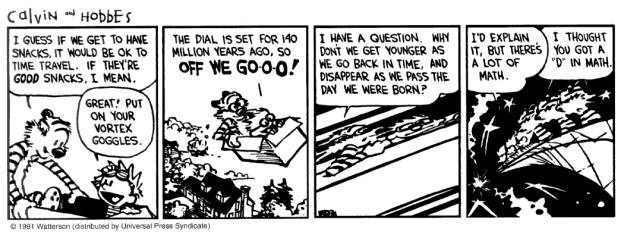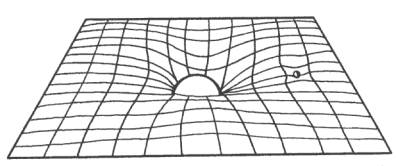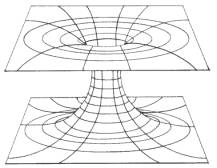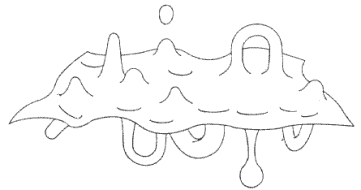Time Travel Research Center © 2005 Cetin BAL - GSM:+90 05366063183 -Turkey / Denizli
Time Travel
In 1905, an obscure Swiss patent office worker wrote a paper that caused an uproar in the scientific community. The paper refuted all the Newtonian physics that scientists knew. The writer of the paper was Albert Einstein. Scientists now accept his Special Relativity Theory and General Relativity Theory as the best theories to explain the universe, or as Stephen W. Hawking (1988, p. 175) put it, to "know the mind of God." If someone were to know the mind of God, he would be omniscient like God. If someone were omniscient, he would know how to take control of time and travel forward and backward at his whims.

Since 1895 when H. G. Wells published his book The Time Machine, the idea of time travel has enamored the American public. Large amounts of literature, usually science fiction, have been dedicated to time travel. On the humorous side of that literature, the Calvin and Hobbes cartoon above contains a truth about Einstein's equations that all physicists know: the Mathematics behind travel into the past and General Relativity is extremely difficult. Arthur Buller also used the ideas behind Einstein's theories in a humorous way in his limerick about "Miss Bright:"
- There was a young lady named Bright,
- Whose speed was far faster than light;
- She set out one day
- In a relative way,
- And returned on the previous night (Davies, 1992, p. 21).
Even though Miss Bright's trip may seem like an idea concocted by Star Trek writers, many respected theoretical physicists have published serious ideas using Einstein's Special and General Theories that may allow travel in time.
To understand how theoretical time travel is possible, one must understand the basics of Einstein's theories. Using Special Relativity, scientists know that time, length, and mass are "not absolute and universal but depend on the observer's state of motion" (Davies, 1992, p. 20). At the speed of light (which, according to Einstein's equations, cannot be reached or exceeded by a body with mass), length decreases to zero, mass increases to infinity, and most importantly, time slows to a stop (Macvey, 1990). Therefore, time is not absolute. An event that took two seconds to a stationary observer would seem to take only one second to a person traveling at 0.87c (87% of the speed of light). Any length would also shrink to half its original length relative to the moving observer and the mass would double.
General Relativity is even more difficult to understand than Special Relativity. In General Relativity, Einstein said that gravity is not a force. Matter distorts and curves spacetime (commonly referred to as the "space-time continuum" by science fiction authors). Projectiles merely attempt to travel in the straightest line possible in the warped spacetime. Using Riemannian geometry (since planar Euclidean geometry does not encompass warped planes), Einstein improved upon Newton's equations of planetary orbit by more accurately describing the path that planets travel. A mass, such as the sun, warps spacetime as a steel ball stretches a taught rubber sheet. (Theoretical physicists call this type of two-dimensional model of spacetime a "spacelike hypersurface.") The larger the mass, the more the rubber sheet stretches (Gribbin, 1983). The "pit" created by the sun catches the planets, which are trying to travel in a straight line. A black hole, which warps spacetime in special ways, can be described as a lead ball that ripped through the rubber spacetime sheet. Anything that falls into a black hole is compressed into a "singularity." Hawking (1993), who has done intensive research with black holes, defines a singularity as a point in spacetime where the spacetime curvature is infinite and where spacetime ends. Wormholes, another result of Einstein's equations that connect two distant points with a short path through spacetime, are thought to appear to be two black holes ("mouths") connected by a passage (a "throat"). However, the passage is very small and wormholes have not even been proven to exist (Lemonick, 1989).

|
Many scientists in Einstein's day refused to accept his results because the equations led to the possibility of time travel. Theoretically, the Special Theory of Relativity allows travel into the future, while the General Theory, under exotic conditions, allows travel into the past. However, the energy and the technology required to accomplish either of these feats are far beyond what anyone in the foreseeable future can dream to use. Using Einstein's theories of relativity, time travel into the future and past are theoretically possible, but are not feasible.
Time travel into the future is commonplace. Humans have been adept at moving steadily into the future since their creation. However, moving appreciably faster into the future than others is more difficult. As already stated, if a traveler could move at a velocity of 0.87c, time on earth would move twice as fast as his time. Therefore, if he were to leave on his birthday and return on what he thought was his next birthday, two years would have passed on Earth. Although this may be useful as a "fountain of youth," it is not useful to serious time travelers. If this traveler could tweak his engine to get it to travel at 0.999 999 999 9c, or one hundred millionth of a percent less than the speed of light, he could travel to Andromeda and back in 55 years. If he were to return to Earth if it still existed, the Earth would have aged 4.7 million years (Macvey, 1990). Most travelers would not want to go that far into the future. However, traveling a 0.999 999 5c, the traveler would only go one thousand years into the future with one year of travel, which could be extremely useful to potential time travelers.
No physical barriers have been proposed yet to prevent time travel into the future. However, no technology known comes even close to accelerating massive starships to such tremendous velocities. Many scientists look at the advancements that the human race has made in the last forty years and speculate that eventually such a ship could be built eventually. Realistically, even if the vehicle was built, the ship would consume enormous amounts of energy. John Macvey (1990) estimates that for a spaceship weighing one ton, the power needed to attain a velocity of 0.8c would be 215 billion kilowatt-hours. All the power stations on the earth combined would need several months to generate that much power. Also, traveling at such high velocities, the impact of the spaceship hitting even a particle of dust would be enormous. The particle could have the inertia of a planet (Davidson, 1990). The force of the collision would easily rip the ship apart. If the prospective time traveler was able build a spaceship, enslave the workers of the world and force them to produce power for himself for several months, he would probably die in his attempt to travel forward to a time where the people of earth had forgotten his tyranny by striking a speck of dust.
Time travel into the past is much more difficult than into the future. To travel into the past, "exotic conditions" are needed to change spacetime in a way that a traveler can go backwards in time (Freedman, 1989, p. 58). To warp spacetime enough to allow the functions of space and time to interchange, a person must travel at relativistic speeds, because no valid conditions are within a close range of the earth. If a traveler could reach suitable conditions, he would encounter many other obstacles. Many scientists believe that "causality" will prevent anyone from traveling to the past (Davidson, 1990). Causality is the normal relationship between cause and effect. If someone could travel back in time, the effect could influence the cause. For example, if Michael J. Fox in Back to the Future had killed his parents, then he would never have been born, which would render him unable to kill his parents. Some theoretical physicists believe that nature protects itself from time travel because of causality violations. Stephen Hawking (in Travis, 1992, p. 180) believes that since the Earth has not been "invaded by hordes of tourists from the future," time travel will never occur. Whenever a new theory is proposed about traveling back in time, other physicists attempt to prove that each is impossible. By playing with Einstein's complicated equations, scientists also learn more about the properties of the universe.

|
Black holes have long been of interest since Einstein's theories predicted them. In a black hole, matter collapses to a point of infinite density, called a singularity. Around the singularity is an event horizon. Once a traveler passes the event horizon, the gravitational pull is so great that the traveler cannot pass back through the event horizon without traveling at a speed greater than the speed of light (Gribbin, 1983). However, another exit may be available. In a rotating black hole, an Einstein-Rosen bridge system develops (Parker, 1991). In this "wormhole," a shuttle could enter and, by orbiting around the singularity to avoid it, could arrive in another universe (Davidson, 1990). Scientists are not sure what this other universe might be. The other universe may be our own universe but in a distant location in space and time or it may be another universe, often called a parallel universe.
However, to reach the "other universe," the traveler must survive the hazards of the black hole. According to Barry Parker (1991), a spaceship attempting to travel through the wormhole in a black hole would be crushed by the wormhole passage pinching off, stretched out by the strong tidal gravitational waves, and "literally fried" by extremely high radiation levels. This grim forecast should deter most travelers from attempting to enter a black hole. If, for some foolhardy reason, a traveler attempted to enter a black hole, he would never reach the event horizon relative to an observer orbiting around the black hole. Time slows down in strong gravitational fields (Parker 1991). Therefore, the traveler's ship would at first accelerate toward the black hole. As the ship would approach the event horizon, however, it would slow down to a virtual stop. If the observer were to see a clock on the ship, the clock would slow down so much that it would appear to stop. The traveler, on the other hand, would feel as though he passed through the event horizon almost instantly (Parker, 1991). Unknown to the traveler, an infinite amount of time would have passed outside the event horizon and he would be cut off from the rest of the universe. The traveler would be forced to travel infinitely into the future and then travel back infinitely into the past to accomplish anything. Because of the number of difficulties associated with travel into a black hole, most theoretical physicists have given up on using black holes to go back in time. Hawking (1993) consoles potential black hole time travelers by stating that even though they would be ripped apart to atoms, their atoms may float into a time in the earth's past.
Although the wormholes connecting black holes are not likely to be useful for time travel, other types of wormholes may exist which do not have singularities in the middle of their throats. Scientists who work on the Plank scale (dealing with objects smaller than 10-33 cm long, which is smaller than an atom) have discovered that tiny wormholes lace spacetime, making a "spacetime foam" of millions of tiny wormholes (Davies, 1992). These wormholes connect different spots in time 10-42 seconds into the past (Deutsch, 1994). If one of these microscopic wormholes could be inflated into a macroscopic wormhole by some means, then it could be used to connect two different points in space and time. By taking one of the mouths and moving it at a relativistic speed away from the other mouth, one end of the wormhole would be younger than the other ("Wormholes," 1988). By traveling from the older one to the younger, a shuttle could go back in time (Allman, 1992).

|
Problems still arise in a wormhole even without a singularity. Wormholes tend to be very unstable, and the if a spaceship entered one of the mouths, the throat would immediately pinch off, crushing the ship (Clarke, 1990). To keep the throat open, negative energy or "exotic matter" equal to the pressure in the center of a neutron star is needed ("Wormholes," 1989). Madhusree Mukerjee (1994) describes negative energy as a "no-no," meaning that physicists do not know how to produce negative energy. Scientists have no idea how to produce any of these "lozenges" to open up the throat. Also, since enlarging a microscopic wormhole would be extremely difficult, a natural wormhole could be used, but the ends of the wormhole would be separated by large expanses of space. Therefore, to return to earth within his lifetime, a traveler would have to travel at relativistic velocities. Even at those high speeds, he probably could not return before he left.
The most recent theoretical model of a time machine has sparked a great deal of dispute, some of which has been appropriately published in the popular newsmagazine Time. The model, proposed by J. Richard Gott III, involves cosmic strings. Cosmic strings are long, thin strings of pure energy left over from the beginning of the universe (Lemonick, 1991). The energy of a cosmic string converted to mass would yield a density of approximately 40 million billion tons per inch (Travis, 1992). By taking two of these strings, placing them parallel to each other, and accelerating each to 0.999 999 999 92c in opposite directions, spacetime becomes extremely curved. By traveling between the strings and then looping around them, Gott calculates that spacetime would be warped enough that when a traveler took off, he could see himself returning (Peterson, 1992). By repeatedly traveling between the strings, multiple spaceships could all be together at once. Edward Farhi of the Massachusetts Institute of Technology remarked that Gott's idea "was so simple that it was tantalizing" (Peterson, 1992, p. 202).
Many physicists were quick to attempt to prove that Gott's idea is impossible. The team of Farhi, Alan H. Guth and Sean M. Carroll from the Harvard-Smithsonian Center for Astrophysics in Cambridge, Massachusetts developed a simplified model called "Flatland" (Peterson, 1992). Ignoring one space dimension and forming a three-dimensional spacetime, Farhi and his colleagues determined that if the universe was open, meaning that it did not contain enough matter to halt its expansion, not enough matter and energy would be present to construct the strings (Travis, 1992).
Gott quickly responded that this analysis may "eliminate his time machine from certain universes, but not necessarily from our own" (Travis, 1992, p. 179). He claims "physicists have a deep-seated belief that things should be causal" and believes that these physicists are saying, "We do not like what [Closed Timelike Curves] imply for physics, so CTCs are unphysical constructs" (Travis, 1992, p. 180). Despite this tirade, Gott himself admits, "Actually, before trying to locate a pair of cosmic strings, it would probably be helpful to locate a single string-something that no one has yet managed to do." He also wistfully states that the speeds that the strings are required travel at are "not any faster than we get electrons to move in the Stanford Linear Accelerator," ignoring that electrons are extremely light while cosmic strings are extremely massive.
Despite these restraints, Gerard 't Hooft of the University of Utrecht in the Netherlands is determined to grind any hope that cosmic strings may work under his heel. He warns, "Don't try [to go back in time using cosmic strings] . . . You won't just fail-you might destroy the entire universe" (Mukerjee, 1994, p. 32). The dilemma described by 't Hooft shows that in a closed universe, the strings cannot pass parallel to each other. Instead, they begin to orbit each other, moving closer and closer together spinning faster and faster. As the kinetic energy of the strings approached infinity, the universe would begin to crumble and collapse in onto the strings. Mukerjee (1994) described the event from the prospective of a potential time traveler: "A time-machine ticket-holder will see massive walls closing in while being shredded to spaghetti by the strings speeding through. . . The scene sketched by 't Hooft shows how such objects can act as Nature's dragons, guarding time machines from fools who would rush in" (p. 32).
Gott, not to be easily dismissed, has proposed a new theoretical puzzle: a finite, rapidly shrinking cosmic loop. This idea will prove more difficult to prove or disprove, because "Flatland" cannot be used. Complete four-dimensional spacetime is needed to fully analyze the phenomenon. However, Gott admits that the system will probably collapse into a black hole, and any time travelers attempting to travel through would be captured behind the event horizon (Peterson, 1992).
Theoretical physicists have been and will continue to introduce new ways to travel in time. Other theoretical physicists will continue to prove that time travel is impossible. Despite optimism from some prominent physicists and science fiction fans, mankind will never "know the mind of God," and therefore will never be able to control the passage of time. Travel into the future will be restricted by the absence of the technology needed to build vehicles capable of velocities close to that of the speed of light and the enormous energy requirements needed to operate the vehicles. Travel into the past will be more violently restricted. Natural phenomena such as crushing singularities, pinching wormholes and collapsing universe will prevent anyone from attempting to violate causality. Stephen Hawking (in Travis, 1992, p. 180) also believes that time machines in general "sow the seeds of their own destruction by creating a small feedback loop in which small fluctuations in the energy of the vacuum travel back in time" and amplify the distortions to astronomical proportions, destroying the time machine the instant it is created. Presently, Hawking is working on a "Chronology Protection Conjecture," which will rule out time machines altogether. Various parts of the conjecture have been proven, including one which states that unless a ship is surrounded by negative energy while attempting to travel back in time, singularities will form around the ship and cut it off from the rest of the universe (Allen, 1992). If a prospective time traveler ever wishes to enter a time machine, he should carefully take heed of the warning Dante to those entering Hell: "All hope abandon, ye who enter here."
Notes
1 Using the formula for mass dilation

where M0 is the rest mass, Mv is the mass of the object in motion, v is the velocity, and c is the speed of light (299 792 458 m/s), the fact that a massive body can only travel below the speed of light can be proven (Macvey 51). By plugging the speed of light into the equation for the velocity,

the rest mass is divided by zero to give the value of the mass in motion, which is undefined and approaches infinity. When a speed greater than the speed of light is used for the velocity, such as 2c,

the rest mass is divided by the square root of a
negative number, which produces a complex or "imaginary" number (![]() ).
Stephen Hawking has proposed an alternate time scale, called "Imaginary
Time," or Ti, which may include time, length,
and mass in parallel universes (Brief 134). The Mathematics
suggests that if the speed of light is exceeded, the travelers may find
themselves in another present in a different universe. Tachyons are the
only particles thought to travel faster than the speed of light. However,
tachyon particles have no mass and therefore the complex part of the
result cancels out.
).
Stephen Hawking has proposed an alternate time scale, called "Imaginary
Time," or Ti, which may include time, length,
and mass in parallel universes (Brief 134). The Mathematics
suggests that if the speed of light is exceeded, the travelers may find
themselves in another present in a different universe. Tachyons are the
only particles thought to travel faster than the speed of light. However,
tachyon particles have no mass and therefore the complex part of the
result cancels out.
2 Using the equation for the
dilation of time,

with Tv (time to an observer in motion) equal to one second, and T0 (time to an observer at rest) equal to two seconds,

the formula yields a result of 87% of the speed of light as the velocity. At this velocity, the moving observer would see things as occurring twice as fast as an observer at rest.
3 Newton's equations stated that
planets travel in a perfectly elliptical orbit around the sun. Einstein's,
however, took into account that the perihelion of Mercury's orbit rotates
around the sun at 43 arc seconds per century. (Macvey 64) The other
planets' orbits, while not as observable as Mercury's, follow a similar
path.
4 Again using the formula for
time dilation,

with Tv equal to one thousand years and T0 equal to one year,

the velocity required is 0.999 999 5c.
Reference List
Allen, B. & Simon, J. (1992, May 7). Time travel on a string. Nature, 357, 19-21.
Allman, W. F. (1988, December 19) Playing fast and loose with time. U.S. News and World Report, 105, 62.
Clark, C. J. S. (1990, November 22). Opening a can of wormholes. Nature, 348, 287-88.
Davidson, M. (1990, January). Is time travel possible? U.S.A. Today, 118, 60-67.
Davies, P. (1992, January). Wormholes and time machines. Sky & Telescope, 83, 20-21.
Deutsch, D. & Lockwood, M. (1994, March). The quantum physics of time travel. Scientific American, 270, 68-74.
Freedman, D. H. (1989, June). Cosmic time travel. Discover, 10, 58-64.
Gribbin, J. (1983). Spacewarps. New York: Delacorte.
Hawking, S. W. (1993). Black holes and baby universes. New York: Bantam.
Hawking, S. W. (1988). A brief history of time. New York: Bantam.
Lemonick, M. D. (1991, May 13). How to go back in time. Time, 137, 74.
Lemonick, M. D. (1989, January 16). Wormholes in the heavens. Time, 155, 55.
Macvey, J. W. (1990). Time travel. Chelsea, MI: Scarborough.
Mukerjee, M. (1994, February). Time-trippers beware. Scientific American, 270, 32.
Parker, B. (1991). Cosmic time travel. New York: Plenum.
Peterson, I. (1992, March 28). Timely questions. Science News, 141, 202-03.
Travis, J. (1992, April 10) Could a pair of cosmic strings open a route into the past? Science, 256, 179-80.
"Wormholes and Time Machines." (1988, November 5). Science News, 134, 302.
"Wormholes, Time Machines and Schrödinger's Cat." (1989, February). Sky & Telescope, 77, 132.
See other papers and read the plagiarism notice.
Alıntı: http://xar.us/stuff/papers/time_travel/#note4
Hiçbir yazı/ resim izinsiz olarak kullanılamaz!! Telif hakları uyarınca bu bir suçtur..! Tüm hakları Çetin BAL' a aittir. Kaynak gösterilmek şartıyla siteden alıntı yapılabilir.
The Time Machine Project © 2005 Cetin BAL - GSM:+90 05366063183 -Turkiye/Denizli
Ana Sayfa /index /Roket bilimi /![]() E-Mail /CetinBAL/Quantum Teleportation-2
E-Mail /CetinBAL/Quantum Teleportation-2
Time Travel Technology /Ziyaretçi Defteri /UFO Technology/Duyuru